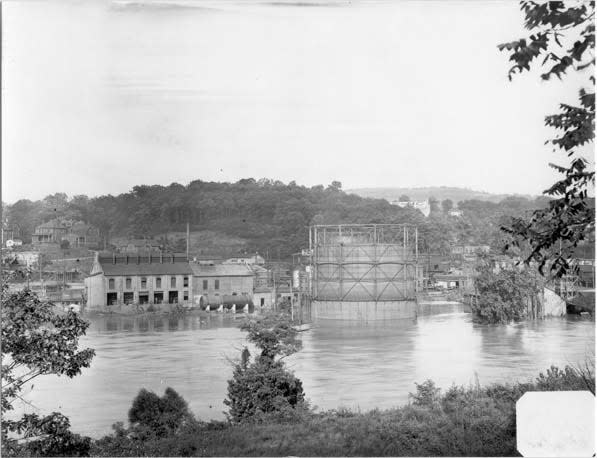Visiting Our Past: Devastating floods have flowed through Asheville's history and folklore

Note: This column was written in 2007, before the 2021 flooding that left six people dead and devastated Cruso and other locations in Western North Carolina.
One of the most enduring images in local memory is one that only words have captured. It's of Biltmore resident Kathleen Lipe hanging onto a tree for more than eight hours as the Swannanoa River, turned monstrous by the flood of July 16, 1916, assaulted her with water and debris.
The torrent had already pulled two family nurses — Charlotte Walker and Mabel Foister — and her father, 60-year old J.C. Lipe, from the tree, but not before her father had secured her with his coat to the trunk. When the waters receded, boaters were able to reach Kathleen, whom they found semiconscious.
The image speaks of the unpredictability of rivers in flood. In Biltmore, water had risen 15 feet in one hour.
On May 28, 1973, David Wayne Woody stepped out of his home in Fowler's Trailer Park in Skyland and saw Robertson Creek rising. As a precaution, he took his 2-year-old son, Christopher, by the hand and his 9-month old daughter, Shannon, in his arms to seek refuge in Clay Ledford's brick house.
On the way, Woody looked back and saw a 4-foot-high wave heading toward him.
A dam constructed on the Brookwood Golf Course had apparently given way. Woody hurried his family into Jason Roberts' trailer, but there was no safety there. The water tumbled and shoved the trailer for a mile, splitting it in half and killing those inside.
Woody's own trailer remained unmoved.
The flood of 1916 is the worst on record in Western North Carolina, but that is only for a specific area. The flood of Aug. 30, 1940, was the worst one to ever pass through Canton, local residents recall.
A.J.L. Moritz, technical vice president of American Enka, stated, "In Hominy Valley the water came considerably higher than during any previously known flood in a history of over 100 years."
Moritz proudly reported in the October 1940 issue of The Enka Voice that after the flood inundated the rayon factory's basements and ground floors, employees got the operation going full throttle in two weeks. "Close to a thousand machines had to be taken apart, cleaned and again put in working order. All equipment, like spools, racks, etc., had to be individually cleaned."
Tragic deaths and heroic rescues are only part of the story of floods. Damage to railroads, bridges and industries, scattered lumber, broken water mains and threatened water supplies, displaced residents, mud slides and ruined crops also figure in the periodic outbursts of nature. And then there are the freakish and comical outcomes.
Hankie Enkie Sr. penned a humorous reflection on the 1940 flood in The Enka Voice in which Moritz's more traditional morale booster had appeared. He reported that employees played a game of "pinch-and-run" with items that had floated out of people's offices.
"Personally," he noted, "I found me three pairs of good socks among Mr. (C.C.) Vanderhooven's (the company president's) collection of unmentionables with which he dazzles his monthly audiences in the gym."
Societal reactions to floods vary. Before industrialization, floods did less damage and restored the soil for crops.
In our urban world, insurance companies step in — as they did in January 1974 with the passage of a federal law requiring municipalities to enforce flood plain management if they wanted to receive other benefits, such as mortgages for public buildings.
Flood timeline
The biggest recorded floods in 200 years of WNC history (as of December 2007):
1796: Fourth week of August.
1800s: A flood during the century's first decade changed the course of the Swannanoa River in Beverly Hills.
1852: Aug. 28.
1891: Feb. 22.
1901: The flood of May 20 saw the French Broad River overflow in Madison and Buncombe counties.
1905: The July 11 flood affected the French Broad River and Hominy Creek.
1916: Both the French Broad and Swannanoa rivers overflowed on July 16.
1928: The Aug. 15 flood affected east Buncombe and McDowell counties.
1940: The Tuckaseegee River flood of Aug. 30 hit Haywood and west Buncombe counties, especially Marshall.
1946: The Aug. 14 flood affected east Buncombe and McDowell counties, particularly Canton.
1973: On May 28 the Hiwassee River flooded parts of Haywood and south Buncombe counties.
2004: Parts of Haywood County were flooded on Sept. 8 and Sept. 17.

Rob Neufeld wrote the local history feature "Visiting Our Past" for the Citizen Times until his death in 2019. This column originally was published Dec. 6, 2007.
This article originally appeared on Asheville Citizen Times: Visiting Our Past: Devastating floods in Asheville's history, folklore

